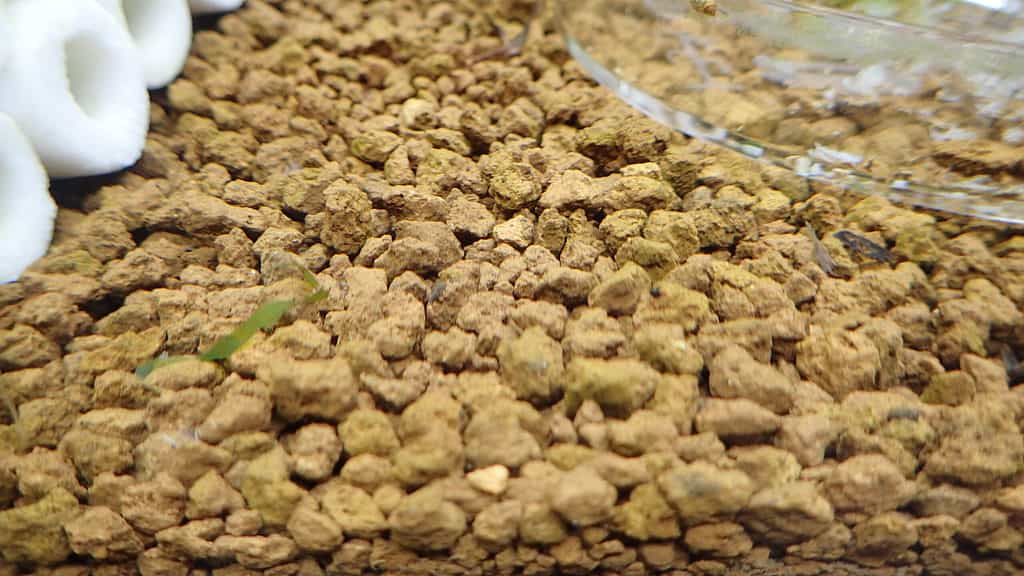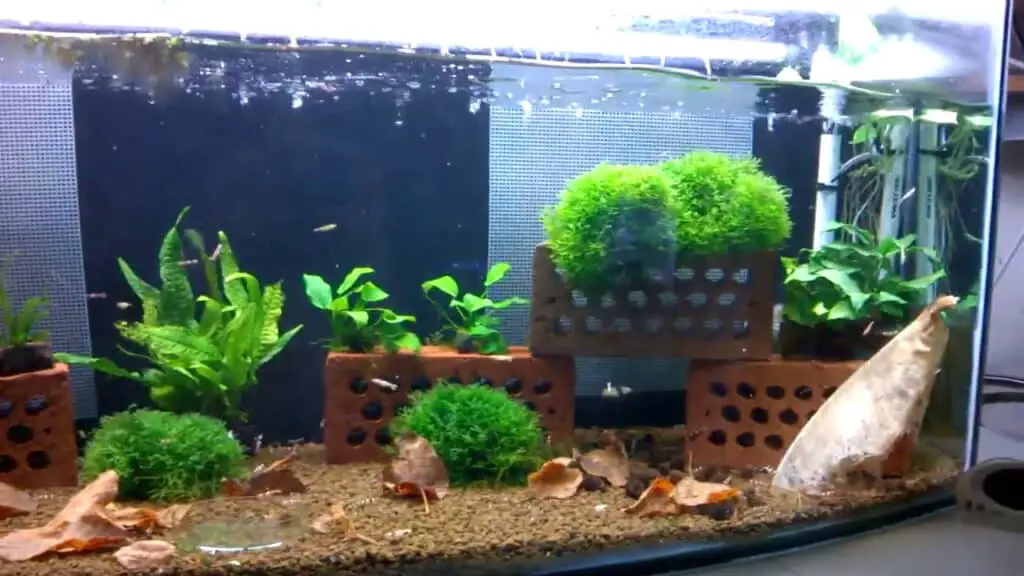With over 40 years of experience in the aquarium world, I’ve seen a lot of trends come and go. But one that’s caught my attention recently is the use of Akadama bonsai soil in shrimp tanks .
.
I remember the first time I saw a shrimp hobbyist using this type of soil. I was intrigued by the vibrant, healthy shrimp and the thriving aquatic plants in their tank. It was then I realized that Akadama bonsai soil was more than just a fad—it was a game-changer.
in their tank. It was then I realized that Akadama bonsai soil was more than just a fad—it was a game-changer.
 – Shrimp Keeping
– Shrimp KeepingUnderstanding Akadama Bonsai Soil
Akadama bonsai soil, a type of clay soil used in bonsai cultivation, has found its way into the shrimp tanks of many hobbyists. This soil is not just any ordinary dirt—it’s a unique substrate that offers several benefits for shrimp and aquatic plants. Its high cation exchange capacity (CEC), ability to lower pH
of many hobbyists. This soil is not just any ordinary dirt—it’s a unique substrate that offers several benefits for shrimp and aquatic plants. Its high cation exchange capacity (CEC), ability to lower pH levels, and long-lasting properties make it a popular choice among shrimp enthusiasts. But before we get into the nitty-gritty of these benefits, it’s important to understand what Akadama bonsai soil is.
levels, and long-lasting properties make it a popular choice among shrimp enthusiasts. But before we get into the nitty-gritty of these benefits, it’s important to understand what Akadama bonsai soil is.
Akadama is a naturally occurring, granular clay that’s predominantly found in Japan. It’s been used for centuries in the cultivation of bonsai trees due to its excellent water retention and nutrient holding capabilities. But these same properties that make it great for bonsai also make it an excellent substrate for shrimp tanks .
.
In the next sections, we’ll delve into the specifics of how Akadama bonsai soil benefits shrimp tanks . But for now, let’s just say that this soil is more than just a pretty face—it’s a powerhouse of benefits for your shrimp
. But for now, let’s just say that this soil is more than just a pretty face—it’s a powerhouse of benefits for your shrimp .
.

The Role of Cation Exchange Capacity (CEC)
Cation Exchange Capacity, or CEC, is a term that might sound a bit intimidating, but it’s actually quite simple. It refers to the ability of a substrate, like Akadama bonsai soil, to hold onto positively charged ions—also known as cations. These cations include essential nutrients like calcium , magnesium, and potassium.
, magnesium, and potassium.
Now, why is this important for your shrimp tank? Well, maintaining stable water chemistry is crucial for the health of your shrimp. A substrate with a high CEC, like Akadama, can hold onto these essential nutrients and slowly release them into the water. This not only provides a steady supply of nutrients for your shrimp but also helps to stabilize the water chemistry, making your tank a more hospitable home for your shrimp.
Moreover, a high CEC substrate also benefits the aquatic plants in your tank. Just like terrestrial plants, aquatic plants need a variety of nutrients to grow. A substrate with a high CEC can keep these nutrients available to plants for longer periods of time, promoting healthier growth.
In short, the high CEC of Akadama bonsai soil is a win-win for both your shrimp and your plants. It’s like having a personal chef and a housekeeper in your tank, taking care of your shrimp’s dietary needs and keeping the environment stable.

How Akadama Bonsai Soil Lowers pH Levels
The pH level of your shrimp tank is more than just a number—it’s a key indicator of the overall health of your tank. Many species of shrimp, especially those originating from soft water habitats, thrive in slightly acidic conditions. This is where Akadama bonsai soil comes into play.
Akadama has a unique property—it naturally lowers the pH level of the water. This is because it slowly releases tannins and other organic acids into the water, which helps to create a more acidic environment. Some shrimp hobbyists have reported pH levels as low as 5.0 when using Akadama, which is ideal for many shrimp species.
But remember, while a lower pH is beneficial for some shrimp, it may not be suitable for all. It’s important to research the specific needs of your shrimp species and monitor the pH levels regularly. After all, knowledge is power, and in this case, it’s the power to create the perfect environment for your shrimp.

The Long-lasting Properties of Akadama Bonsai Soil
In the world of shrimp keeping, we’re always on the lookout for products that offer long-term benefits. And Akadama bonsai soil is one such product. This soil isn’t just a one-hit-wonder—it’s a substrate that keeps on giving.
One of the standout features of Akadama is its longevity. Some shrimp hobbyists have reported that it lasts for up to 2 years before needing to be replaced. This is quite impressive when compared to other substrates that may need to be replaced more frequently.
This long-lasting property of Akadama not only makes it a cost-effective choice but also reduces the disturbance to your shrimp. Replacing the substrate can be a stressful event for your shrimp, so having a substrate that lasts longer can help to create a more stable environment.
However, it’s important to note that the longevity of Akadama can vary depending on factors like the size of your tank, the number of shrimp, and the types of plants you have. So, while Akadama is generally long-lasting, it’s always a good idea to keep an eye on its condition and replace it when necessary.

Conclusion
Akadama bonsai soil is more than just a substrate—it’s a tool that can help you create a thriving environment for your shrimp. Its high Cation Exchange Capacity (CEC), ability to lower pH levels, and long-lasting properties make it a popular choice among shrimp hobbyists. But like any tool, it’s important to understand how to use it effectively. Regularly monitor your tank’s pH levels and replace the Akadama soil when necessary to ensure the best conditions for your shrimp.
Remember, every shrimp tank is unique, and what works for one might not work for another. So, don’t be afraid to experiment and find what works best for your shrimp. After all, shrimp keeping is as much an art as it is a science.
If you have any questions or need further assistance, don’t hesitate to reach out. I’m here to help you navigate the fascinating world of shrimp keeping. Happy Shrimp Keeping!
FAQ
Q: What is Aquarium Active Soil? A: Aquarium Active Soil is a type of substrate specifically designed for use in planted aquariums. It is made from natural materials like volcanic soil and contains essential nutrients and minerals that promote plant growth.
Q: What is Cation Exchange Capacity (CEC)? A: Cation Exchange Capacity (CEC) is a measure of a substrate’s ability to hold onto positively charged ions, or cations, like calcium, magnesium, and potassium. A substrate with a high CEC will be able to hold onto more of these nutrients, making them available to plants over a longer period of time.
Q: Why is Cation Exchange Capacity important for planted aquariums? A: Plants in aquariums need a variety of nutrients to grow, including calcium, magnesium, and potassium. If the substrate in the aquarium has a low CEC, these nutrients may quickly become depleted, leading to poor plant growth. A substrate with a high CEC can help to keep these nutrients available to plants for longer periods of time, promoting healthier growth.
Q: How is Cation Exchange Capacity measured? A: Cation Exchange Capacity is measured in milliequivalents per 100 grams of substrate (meq/100g). This is typically done in a laboratory setting using a process called the ammonium acetate method.
Q: What is a good Cation Exchange Capacity for Aquarium Active Soil? A: A Cation Exchange Capacity of around 20-30 meq/100g is considered good for Aquarium Active Soil. However, the specific needs of your aquarium may vary depending on factors like the types of plants you are growing and the size of your aquarium.
Q: Can Aquarium Active Soil be reused? A: Aquarium Active Soil can be reused, but it may need to be recharged with nutrients before being used again. This can be done by adding fertilizer to the substrate or by mixing in fresh substrate to provide additional nutrients.
Q: How often should Aquarium Active Soil be replaced? A: The frequency with which Aquarium Active Soil needs to be replaced will depend on factors like the size of your aquarium, the types of plants you are growing, and how heavily stocked your aquarium is. As a general rule, it is a good idea to replace your substrate every 2-3 years to ensure that it is still providing adequate nutrients to your plants.
Meta Description
Discover the benefits of using Akadama bonsai soil in shrimp tanks. Learn about its high Cation Exchange Capacity, pH-lowering properties, and longevity. Dive into our detailed guide and become a shrimp keeping expert!
